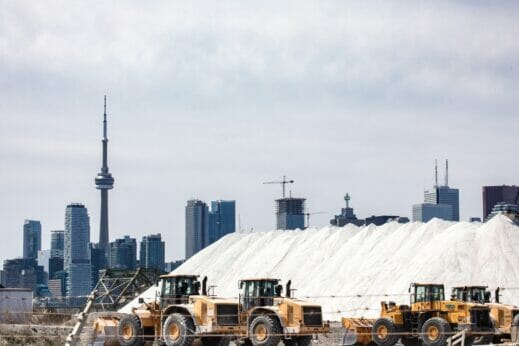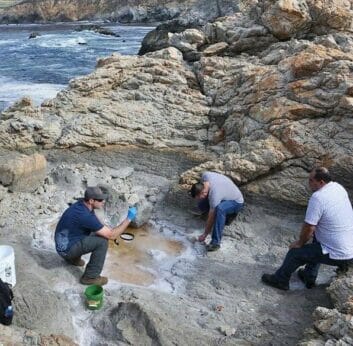To survive in the age of climate change, salt farmers from around the world will have to adjust their production methods and revenue streams.

Salt is all around us—inside our oceans, beneath our feet, on our roadways, in our food and as part of the products we use every day. But with global temperatures climbing, weather events becoming more extreme and sea levels rising, salt producers in every corner of the globe face an uncertain future.
A $30-billion global industry, salt is a crucial food preservative, a keystone mineral in manufacturing and a common de-icing agent in chilly climes such as New York, Ohio and Illinois. Before industrial mining became widely available in the 20th century, “all salt was made from sea,” says Icelandic salt farmer Björn Steiner Jónsson. But today, most of the salt Americans use comes from underground deposits harvested in two energy-intensive ways: mining salt like a mineral and injecting water into salt deposits to create a brine that is then evaporated—a more expensive process, notes Jónsson.
For some farmers, lower humidity and higher temperatures have increased evaporation, creating a boon in the salt pans of northwest France, with the 2022 harvest reportedly nearly doubling the previous year’s yield. For others, warmer weather is decreasing production. Anna Lee, who farms salt with her husband Dave along Virginia’s Eastern Shore, says their company already halts production in the hottest months of the year when toxic algae blooms and increased microbial activity make harvesting unsafe.
Lurking in the background, too, is the knowledge that Barrier Islands Salt Co.’s shoreline solar evaporative pans, made from repurposed aquaculture infrastructure, could be rendered inoperable under rising seas. Today, “at high, high tides, our actual ground floor location can flood,” says Lee. Years from now, Barrier Islands Salt Co. might have to modify its operations significantly or relocate, “so that’s concerning,” she adds.

Piles of salt for road de-icing sit on Toronto’s waterfront. (Photo: Shutterstock)
Even salt trapped in underground veins isn’t immune to rising temperatures. Rock salt makes up the bulk of the $2.5-billion US market, and Canada holds the title of greatest salt consumption per capita, mostly in the form of de-icer. Warmer global temperatures mean decreased demand for de-icing salt, forcing suppliers to adjust to new climate conditions.
Concurrently, erratic precipitation patterns are forcing farmers in Ghana and Indonesia to erect seasonally resistant infrastructure that allows for production even under the most severe weather conditions. In India, the world’s third-largest salt producer, longer rainy seasons have reduced brine harvests, financially crippling the Agariya people who have farmed the salt marshes for five generations. The switch from propane to solar-powered pumps has the potential to help stabilize this fluctuating market and secure the livelihoods of these subsistence farmers—all while reducing the emissions associated with production.
When atmospheric rivers swept through California in early 2023, salt farmer Carlo Overhulser spent days pumping thousands of gallons of fresh water out of his cliff-side cool saltwater pools. Not only did he lose time draining and refilling the pools with salt water, but the wetter weather also caused slower solar evaporation, substantially affecting Big Sur Salts’ annual harvest. “Normally, I can flip those ponds three times a year,” he says. “Now, I’m probably only going to be dealing with two.”

A natural salt pond operated by Big Sur Salts. (Photo courtesy of Coline LeConte)
To stay in business, says Overhulser, farmers must be willing to adjust to fluctuating weather patterns and pivot accordingly. “In hotter, drier years, you have to produce more because you have to make up for the years that you’re not going to do that,” he says. He’s also bracing against the unpredictable nature of salt farming by expanding his offerings to include a host of salt-related activities: tours of the ponds, saltwater yoga classes and ocean-to-table dining experiences.
In addition to solar-evaporated sea salt, Overhulser produces flake salt inside hoop greenhouses using propane-run evaporative pans. Burning gas, he laughs, “is not the Big Sur way to do it.” Still, given a future of weather irregularity, the cost efficiency of propane and a market hungry for these types of specialty salts, fossil fuels remain the best option for many flake salt farmers. Lee reluctantly agrees. “You can obviously make a fine-grain salt from start to finish with solar, but if you want flake salt, you have to be able to really, really control the environment.”

Barrier Island Salt Co. harvests its salt on the open waters of the Atlantic Ocean. (Photo credit: Corey Miller Photography)
Jónsson makes his salt in a controlled environment, but unlike other operations dependent on fossil fuels, Saltverk’s farm in the remote Westfjords uses “alternative ways of production where you’re able to do it in harmony with your ecosystem,” he says. The entire salt-making process is powered by emissions-free geothermal energy. Seawater from the North Arctic Ocean is pumped into open evaporative pans where it is pre-heated, boiled and dried, making Saltverk one of the world’s only fully sustainable flaky sea salt farms. The company is even investigating ways to produce salt with energy generated by geyser water previously used in industrial activity.
Whereas many salt farmers are strategizing ways to prevent or offset losses caused by the consequences of climate change, Saltverk’s carbon-free, weather-resilient production has prepared the company for expansion. Saltverk recently began exporting to the US, adding to the approximately 17,000 metric tons of salt imported annually. Jónsson plans to add more farms in Iceland and elsewhere in Europe.
The future of salt, according to Overhulser, will depend on the harvesters themselves. Salt farmers in the Anthropocene will have to transform their old ideas about both harvesting methods and revenue streams into new, more adaptable models as disruptions in climate patterns upend salt production and consumption around the world. Like Overhulser says, “It reminds you to not turn your back on the ocean.”
This is moderately interesting, but I would prefer that Modern Farmer stick with farming [living organisms] and not expand into mining. Lithium brine, leaching of gold ore with fluids, and many other mineral extraction processes use water and are impacted by climate change and variation. There are plenty of media venues for that discussion. It ain’t farming.